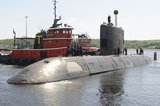USS Abraham Lincoln completes CSSQT
US Navy Nimitz-class aircraft carrier, USS Abraham Lincoln, successfully completed testing of its self-defence system (SSDS) capabilities during Combat Systems Ship Qualification Trials (CSSQT) on 7 December.
During trials, the ship demonstrated its ability to safely and effectively operate onboard weapons systems. In addition to the close-in weapons system (CIWS), Abraham Lincoln fired one RIM-162 Evolved Sea Sparrow Missile (ESSM) and one RIM-116 test Rolling Airframe Missile (RAM). Each missile successfully intercepted subsonic, sea-skimming UAS targets.
The ESSM is a semi-active missile requiring a feed from operators to locate a target. The RAM is a passive missile that uses built-in sensors to track down its target. The ship’s ENSSMS holds eight missiles per launcher, and the RAM launchers each hold 21 missiles.
CSQTT also demonstrated the mission-readiness of Carrier Strike Group (CSG) 12. The Abraham Lincoln CSG is comprised of Carrier Air Wing 7, Destroyer Squadron 2, associated guided-missile destroyers, flagship Abraham Lincoln and the Ticonderoga-class guided missile cruiser USS Leyte Gulf.
Related Equipment in Defence Insight
More from Naval Warfare
-
![Will the US Navy surge production for OTH-WS missile?]()
Will the US Navy surge production for OTH-WS missile?
The USN is conducting a market search seeking additional sources capable of supplying 516 units of Over the Horizon – Weapons System Encanistered Missiles.
-
![Maritime defence in the Mediterranean faces challenges from vulnerable land power]()
Maritime defence in the Mediterranean faces challenges from vulnerable land power
As an indispensable energy crossroads, the Mediterranean is at serious risk from grey zone disruption. As navies increasingly employ AI data centres, what happens when cutting-edge defence technologies rely on the very infrastructure most susceptible to hybrid tactics?
-
![US Navy to conduct an experimentation campaign with emerging tech in 2026 and 2027]()
US Navy to conduct an experimentation campaign with emerging tech in 2026 and 2027
The Technology Operational Experimentation Events will inform future requirements as the US Navy looks for innovative solutions across three key operational domains.
-
![Future Canadian Continental Defence Corvette will provide “Halifax-equivalent capabilities”]()
Future Canadian Continental Defence Corvette will provide “Halifax-equivalent capabilities”
Although the CDC project is still in its early stages, the Canadian Department of National Defence already has some requirements for the future platforms.





















